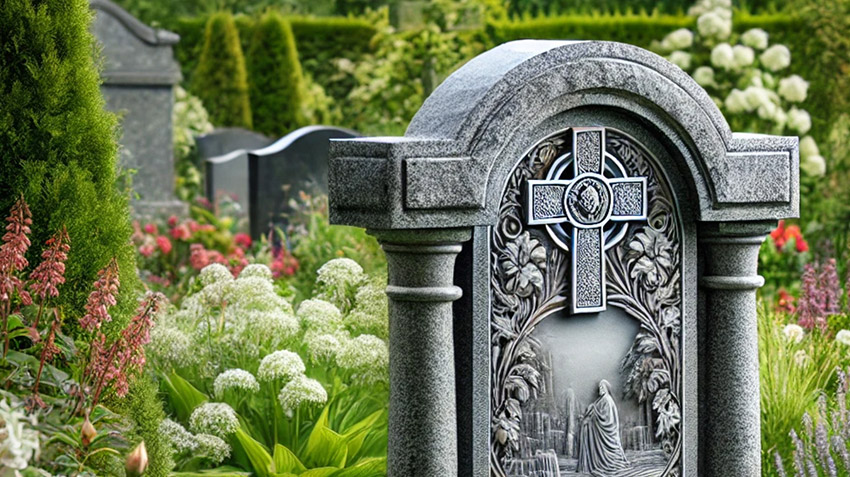
A headstone can serve as a physical reminder of a loved one who has passed away.
These structures provide a place for you and your family to pay respects to your loved one after their burial.
When you’re grieving, choosing a headstone can be the last thing on your mind but is an important part of any funeral. Also, there are many types of funeral headstones, featuring various designs and sizes.
Additionally, the average cost of a headstone in the USA is between $1,000-$3,000, but this cost can vary depending on the material used to make the headstone and what kinds of modifications you want to make to it.
If you’re unaware of the different types of funeral headstones, this blog post will explain each type of headstone so that you can find one that is right for your loved one’s gravesite.
The Types of Headstones
Here are the various kinds of headstones:
1. Upright Headstones
These are the most common types of headstones used in cemeteries. They’re made using a vertical slab that’s mounted on a base.
These headstones are normally made from granite, concrete, or marble. They can also be customized into all sorts of shapes, such as pointed tops and curved tops. Also, headstones have a lot of space to include epitaphs and decorative elements, like small portraits.
2. Flat Headstones
Flat headstones, as the name suggests, are designed to lie flat on the ground. Normally, these headstones are made from granite and bronze. They can be either square or rectangular.
These headstones are favored for their simple design. Also, they’re easier to maintain than most headstone types. Like upright headstones, flat headstones also have plenty of room to include inscriptions and engravings.
3. Slanted Headstones
Slanted headstones are a type of upright headstone, but their faces are slanted upward at a 45-degree angle. The advantage of this design is that it makes the inscription easier to read from a distance.
These headstones can be placed directly on the ground or on top of a slab for extra stability.
4. Kerbed Headstones
These types of funeral headstones have a stone border that covers the entire grave and the inside of this border can be filled with plants or smaller stones for decorative purposes. This type of headstone offers more space for inscriptions and other types of decorations as compared to other types of headstones.
In addition, this headstone is a good choice if you want to give your loved one a more elaborate burial place. For instance, you can plant your loved one’s favorite flowers inside the border to create a more meaningful resting place.
5. Cremation Memorials
If you plan on cremating your loved one or your loved one mentioned in their will that they want to be cremated, you can still choose to bury their ashes after cremation, given that your loved one didn’t ask for their ashes to be scattered. This is usually the case with Catholic cremations.
In this case, you can choose cremation memorials, which are smaller versions of upright headstones, plaques, and sometimes replica urns. There are also cremation benches, which create a seating area around where the ashes are buried.
6. Bench Headstones
Bench headstones serve as seating and a memorial, not too different from cremation memorials. These headstones are typically made from durable materials, like granite, and they can be decorated.
Also, they provide a peaceful space for loved ones of the deceased to sit down and reflect.
7. Obelisk Monuments
Obelisks are large, four-sided headstones that can be several feet tall. While obelisks aren’t as common as other headstones, they can be used to memorialize someone who made a huge contribution to society, like a veteran or a philanthropist.
Materials for Headstones
Here are the material headstones can be made out of:
1. Granite
Thanks to its durability, granite is the most common material used for headstones. It can come in a range of colors, from black to yellow and can be polished to give it a shiny finish.
2. Bronze
Bronze is usually used for flat headstones because it can be cast into many intricate designs. Usually, bronze flat headstones are placed on a granite base to give them more stability.
3. Marble
Marble can be used to create beautiful headstones with a smooth texture. However, marble can be hard to maintain as it isn’t very durable; it can easily chip and acidic rainwater can cause it to erode.
4. Slate
Slate can give headstones a rustic look, but it’s not a very durable material and isn’t commonly used today. You may see a lot of slate headstones in old cemeteries that date back to the 19th century.
Frequently Asked Questions
Have questions about different types of headstones? Consider these questions and answers below:
1. What should be written on a headstone?
The name of the deceased, their dates of birth and death, and a short description of who they were in life. You may also add poems or lines from the deceased’s favorite songs to the headstone to make it feel more personal.
2. Can a person choose to be buried without a headstone?
Yes, in most cases, a headstone isn’t mandatory. However, some cemeteries may have rules that state otherwise so it’s best to check with a cemetery’s management about their headstone policies.
3. Can I have a headstone moved?
To move a loved one’s headstone, you must speak to the cemetery’s management. While most cemeteries may allow you to modify a headstone, not many will allow you to relocate it.
Learn more about the types of funeral headstones
Even after learning about the many kinds of funeral headstones, it can be difficult to decide which one is best for preserving your loved one’s memory. This is where a funeral home can help you.
Helping you find the right headstone for your loved one is a big part of their professional funeral services. So don’t be afraid to ask them for advice—they’ll help you choose a headstone that fits your budget and perfectly immortalizes your loved one.



